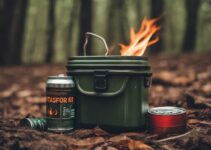Most people aren't aware that the composition of canned heat can greatly influence its safety and efficiency. As someone who values safety and practical knowledge, I've learned that understanding the nuances of utilizing canned heat goes beyond just striking a match. Selecting an appropriate location and ensuring proper ventilation are just the tip of the iceberg. In the following discussion, I'll share five essential tips that cover everything from safe lighting to effective extinguishing techniques. This insight could make a significant difference in how you approach this seemingly simple task, potentially saving you from unforeseen hazards.
Key Takeaways
- Always use canned heat in well-ventilated, outdoor areas to prevent hazardous situations.
- Follow the manufacturer's instructions for lighting to ensure safe ignition and use.
- Never leave canned heat unattended, monitoring the flame continuously for safety.
- Use a metal lid or snuffer for extinguishing the flame to prevent accidents.
Selecting a Safe Location
When using canned heat, it's important to select a location that's both well-ventilated and away from any flammable materials, ensuring a safe environment for all involved. Outdoor usage is often ideal because it naturally provides the ventilation needed to disperse any fumes that might accumulate. However, it's essential to pay attention to surface stability. The surface on which the canned heat is placed must be level and sturdy. An unstable surface can lead to accidents, such as the can tipping over, which could ignite nearby materials. I always make sure to place it on a solid, non-flammable base, like concrete or metal, to reduce any risk of accidents. This approach has kept me and those around me safe during numerous outdoor events.
Proper Ventilation Is Key
Ensuring proper ventilation is vital when utilizing canned heat, as it greatly reduces the risk of inhaling harmful fumes and enhances safety for everyone involved. Maintaining good indoor air quality is paramount, and here's how I make sure of that:
- Open Windows and Doors: To guarantee a fresh air supply and prevent the buildup of toxic gases.
- Use Exhaust Fans: Especially in closed areas, activating ventilation systems helps circulate air effectively.
- Avoid Enclosed Spaces: Never use canned heat in areas without adequate airflow.
- Check Ventilation Systems Regularly: Ensuring they're in working order guarantees the removal of contaminated indoor air.
Lighting Canned Heat Safely
Having discussed how to maintain good indoor air quality, it's also important to know the correct way to ignite canned heat to avoid accidents and guarantee everyone's safety. When lighting canned heat, the type of fuel and the ignition tools you use are paramount. Different fuel types, such as ethanol or methanol, have their specific properties and safety measures. Always read the manufacturer's instructions to match the fuel type with the correct ignition tool, typically a long-reach lighter or matches, to ensure a safe distance between your hand and the flame. Never use homemade tools or shortcuts for ignition. This methodical approach not only prevents mishaps but also instills a safety-first mindset when handling canned heat.
Monitoring Flame Continuously
Once you've ignited the canned heat, it's important to keep a vigilant eye on the flame at all times to prevent any unforeseen hazards. Monitoring the flame continuously is vital for safety and efficiency. Here's how I guarantee it:
- Check Flame Color: A healthy flame should be blue, indicating complete combustion. Yellow or orange flames suggest impurities or incomplete burning, which requires adjustment.
- Assess Heat Intensity: High flames might indicate too much fuel consumption, while a dim flame suggests low heat output.
- Stay Nearby: Never leave canned heat unattended. A sudden flare-up or spill could be dangerous if not addressed immediately.
- Shield From Wind: Wind can cause the flame to behave unpredictably. Shielding ensures consistent heat intensity and flame color.
Extinguishing Techniques
To safely conclude the use of canned heat, it's important to master the proper extinguishing techniques, preventing any risk of fire or injury. Initially, never attempt to blow out the flame directly, as this could spread the fuel and cause a larger fire. Instead, if available, use a metal lid or snuffer to cover the can, depriving it of oxygen and extinguishing the flame. For larger incidents or if the flame becomes uncontrollable, having a fire blanket within easy reach can be a lifesaver. Lay it over the flame to smother it efficiently. Ultimately, if the situation escalates beyond control, don't hesitate to call emergency services immediately. Remember, your safety and the safety of those around you should always be the priority.
Frequently Asked Questions
Can Canned Heat Containers Be Reused or Refilled Once They're Empty?
I've always wondered if I could reuse or refill my canned heat containers. Turns out, for safety's sake, it's not recommended. However, recycling tips and container crafts offer creative ways to repurpose them responsibly.
How Should Canned Heat Be Stored When Not in Use to Maintain Its Effectiveness and Safety?
I store my canned heat in a cool, dry place to make sure it remains effective and safe. Temperature control is essential; it prevents leakage or spoilage. Always check the storage location's suitability before storing.
Are There Any Health Risks Associated With Using Canned Heat Indoors for Cooking or Heating Purposes?
I've always enjoyed a cozy, indoor campfire, but let's talk brass tacks. Using canned heat indoors without proper ventilation can lead to health symptoms like headaches or dizziness. It's important to keep it airy!
Can Canned Heat Be Used as a Reliable Heat Source in Emergency Situations, Such as Power Outages or Natural Disasters?
Absolutely, canned heat's ideal for emergency situations like power outages. It's outdoor suitable, minimizing environmental impact. However, it's vital to use it safely, preventing accidents and ensuring it serves as a reliable, effective heat source.
How Does the Efficiency and Cost of Using Canned Heat Compare to Other Portable Heating or Cooking Solutions?
I've found canned heat's fuel efficiency to be quite competitive compared to alternative fuels. It's cost-effective for short-term use, but for prolonged periods, carefully consider its efficiency and safety alongside other portable heating options.





